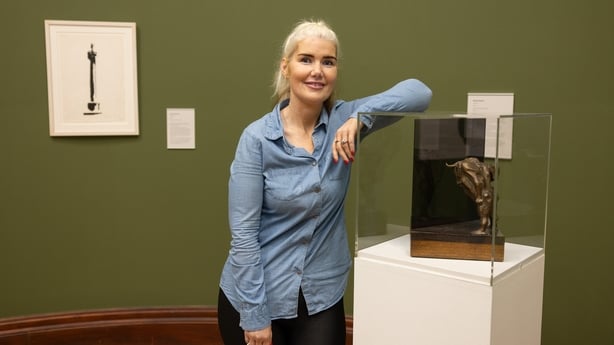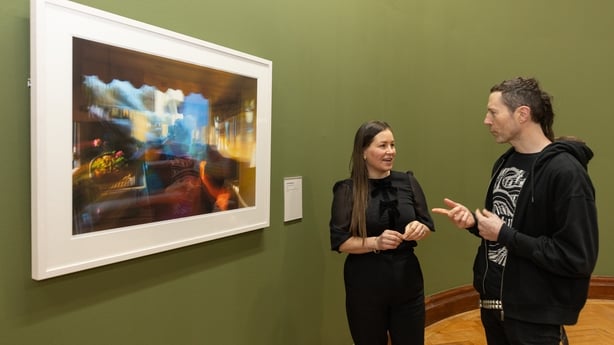Currently showing at the Hugh Lane, Dublin, Bafushia is a new exhibition which gives stirring and vivid insights into the lived experience of Travellers.
Curated and organised in collaboration with artist Séamus Nolan and Pavee Point Traveller & Roma Centre, the exhibition features work by contemporary Irish artists who share Traveller heritage: Chloe McDonagh, David McDonagh, Frank McCarthy, Leanne McDonagh, Paddy Collins and William Cauley.
Below, in an extract from a publication accompanying the exhibition, Traveller writer and activist Dr Rosaleen McDonagh make the case for a Traveller Art as "an integral component of our struggle for political & cultural survival."
While reflecting on Lady Gregory's 1903 essay, Our Irish Theatre: A Chapter of Autobiography, her call rings sharp: "We must make our own propaganda." Engaging critically with Gregory’s ideas, we uncover both parallels and tensions between her cultural revival and the Traveller Renaissance we see today. Gregory’s essay wrestles with colonialism and its lingering debris, articulating the urgency of dismantling derogatory Irish stereotypes—like the "pig in the parlor." Her concern for the Irish psyche, its self-esteem and sense of self-worth, offers a stirring vision.
Her thesis was unflinching: art could confront colonialism and racism head-on. Her words speak to me now, as an Irish Traveller bearing witness to a Traveller Renaissance. For Travellers, her essay resonates deeply. For our community, art isn’t just celebration - it’s resistance. It’s survival. It’s defiance against the tide of assimilation.
Where Gregory sought to reclaim Irish culture from colonial erasure, Traveller art seeks to dismantle internal hierarchies and elevate diverse voices within Ireland’s broader cultural canon.

with 'Impact', a sculpture by Michael Ayrton
Our moment as Traveller creatives has arrived - a vibrant energy driving what I dare to call a Traveller art Renaissance. This Renaissance builds on a legacy of music, storytelling, embroidery, tin smithing, and other crafts rooted in everyday life. Our art has always been purposeful. Yet, when Traveller art is mentioned in historical contexts, it often centers on settled people’s representations of us—their misappropriations of our artefacts, histories, and identities. Institutional racism reinforced stereotypes through museums and cultural institutions, locking our stories out of reach. We had no access to theatres or galleries to see ourselves reflected. The ether carried those tropes, but access was a privilege Travellers rarely held.
Celebration of Traveller art cannot come at the expense of confronting the deeper systemic issues our community faces. A grant or bursary alone cannot erase centuries of exclusion.

Emma Blain (R), standing between a portrait by David McDonagh entitled
'Not Acting - Portrait of Stephen Casey Bracken' at the launch of Bafushia
The Paradox of Recognition
Today, Traveller artists are celebrated in exhibitions but often lack institutional backing or sustained support for professional development. This pattern reflects a troubling trend: arts funding for "diverse" cultures does little for the communities these cultures emerge from. Traveller art risks being consumed as an object—a static relic—rather than seen as a living, evolving act of cultural resistance. Local authorities may fund art projects while simultaneously denying our community culturally appropriate accommodations. The paradox is glaring.
Including Traveller art in mainstream spaces, without addressing systemic inequality, reinforces power imbalances. Traveller artists are often relegated to "folk" or "ethnic" creators, their work celebrated for its quaintness but dismissed as peripheral to Irish art. For too long, settled artists caricatured our stories for settled audiences, stripping our dignity in the name of entertainment. We understand the nuances of the racist tropes embedded in those portrayals.
Similar as Black artists have fought systemic racism to have their voices heard. When the arts sector reflects only a narrow segment of society, it excludes both the artist and their audience.
Traveller art must reshape Irish culture, challenging dominant narratives while nurturing our community from within.
Art as Resistance
Traveller art, in all its forms, is resistance. It is survival in the face of systemic racism. Labeling it "craft" or "heritage" diminishes its power to challenge stereotypes. Instead, Traveller art inhabits Homi Bhabha’s "third space," where identity resists simplistic categorization. To truly transform the Irish art world, we must dismantle the entrenched structures that limit our potential. This requires reimagining what it means to be Irish—and an Irish Traveller—in an equitable society.
Curatorial Control
Aruna D’Souza critiques the power structures of curatorial control, reminding us that inclusivity must go beyond token gestures. Traveller artists need ownership of our cultural artefacts—not just to be included but to curate and administer our work. Decolonizing the art world means dismantling the colonial frameworks that position our stories as marginal. Traveller artists must frame our experiences, using our authority to challenge the status quo. Without equitable funding and systemic reform, recognition will remain an empty gesture.
As Edward Said’s analysis of Orientalism shows, perpetuating colonial power dynamics through "high art" while marginalizing "folk art" is a dangerous trap. The question isn’t whether Traveller art can be included—it’s whether the structures sustaining the art world can reform to embrace the diversity of Irish society.

with Bafushia curator Séamus Nolan
The Art of Defiance
For Traveller artists, inclusion is not enough. We demand ownership of the spaces that claim to welcome us. Claudia Rankine’s call for an art world that confronts its biases cannot remain an ideal; it is a necessity. Traveller art must reshape Irish culture, challenging dominant narratives while nurturing our community from within.
This provocation is not one-sided. Artists - Traveller or otherwise - must be free to create without the weight of representation. My own politics inform my work as a playwright, rooted in Traveller identity. Yet the provocation remains: will the institutions that invite us ever truly integrate our voices, or will they keep us at the margins? Kimberlé Crenshaw’s intersectionality reminds us that the compounded discrimination facing Traveller women must be addressed in both artistic and political realms. Traveller art is no monolith—it’s a multitude of voices demanding to be seen and heard.
This is our moment. We must be bold enough to showcase our work, to accept critique from peers and mainstream critics alike. Non-Travellers must engage with our art critically, without fear of perpetuating stereotypes. Through this engagement, art becomes transformative - personally, communally, politically. The test isn’t in being featured; it’s in redefining the spaces that feature us. Equity demands that our voices shape these spaces from within. As James Baldwin said, recognition is not just a gesture—it’s an act of defiance, compelling the world to see us as we are.
Bafushia (a physically bound process of forward movement) is at the Hugh Lane, Dublin until April 27th 2025 - find out more here.

